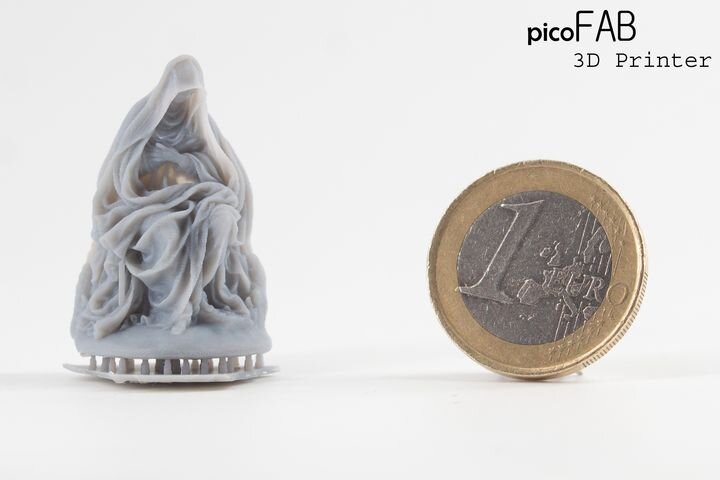![The upcoming PicoFAB resin 3D printer [without case] [Source: Lumi Industries]](https://fabbaloo.com/wp-content/uploads/2020/05/image-asset_img_5eb050ae2a2f9.jpg)
We’ve been tipped that Italy-based Lumi Industries is developing a very high resolution, but tiny, resin 3D printer they call the PicoFAB.
The PicoFAB’s build volume is indeed tiny: only 24 x 24 x 50 mm. That’s even smaller than many of the jewelry 3D printers we’ve seen.
Normally, jewelry 3D printers have tiny build volumes not only because most jewelry isn’t large, but also because in order to achieve higher resolutions from DLP light engines inside the device. Basically, the array of pixels is focused on a smaller area, making for higher resolution. Could that be what’s happening in the PicoFAB?
![Sample 3D print from the PicoFAB resin 3D printer [Source: Lumi Industries]](https://fabbaloo.com/wp-content/uploads/2020/05/image-asset_img_5eb050ae7a5d5.jpg)
Maybe not: the PicoFAB has 0.1mm XY resolution, which is good but not spectacular. In addition, the PicoFAB can make layers as small as 0.025mm, which is very fine.
They say the machine is the result of a unique light engine:
“Today, Lumi Industries presents their latest project: a resin 3D printer for functional parts with an exceptional detail, with a price under 150 euro. This has been possible thanks to a compact light engine that we developed.”
That’s the really important part: the price, €150 (US$165) is perhaps the lowest one could expect for a high-resolution 3D printer.
But is the PicoFAB too small? For many projects, it obviously would be, but there are plenty of applications where the parts are small and low throughput is acceptable. Luminary’s Industries says they believe some labs require a very small resin 3D printer to test highly expensive resins before they commit to buying larger quantities. The PicoFAB requires only 15-20ml of resin to operate, far lower than any other resin 3D printer I am aware of.
That could be a good application for the PicoFAB, and it could mean that the PicoFAB would be a kind of “extra” 3D printer in a workshop used for special testing only.
![Sample 3D print from the PicoFAB resin 3D printer [Source: Lumi Industries]](https://fabbaloo.com/wp-content/uploads/2020/05/image-asset_img_5eb050af04593.jpg)
For jewelry, the PicoFAB is a bit small, but there are still plenty of jewelry designs that would fit within the build volume of this tiny 3D printer.
Lumi Industries says the PicoFAB works with 405nm resin, as do most resin 3D printers, but they are also developing a 385nm version for those requiring it.
![The PicoCLEAN wash station for the PicoFAB 3D printer [Source: Lumi Industries]](https://fabbaloo.com/wp-content/uploads/2020/05/image-asset_img_5eb050af4ab06.jpg)
Anyone who’s 3D printed with a resin machine will say that the job isn’t complete until the print is washed of stray resin and cured to final form with a bath of UV light. Lumi Industries has taken up this challenge by developing the picoCLEAN and the PicoCURE, two accessories that perform those functions.
It’s clear that Lumi Industries is still developing the device, as you can see in the image at top that the machine doesn’t yet have a cover! But that will certainly be completed by the time the PicoFAB is launched via Kickstarter later next month.
Via Lumi Industries

